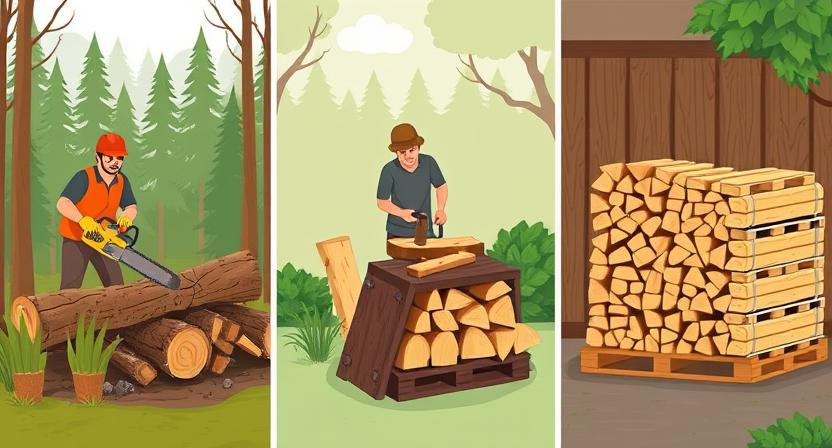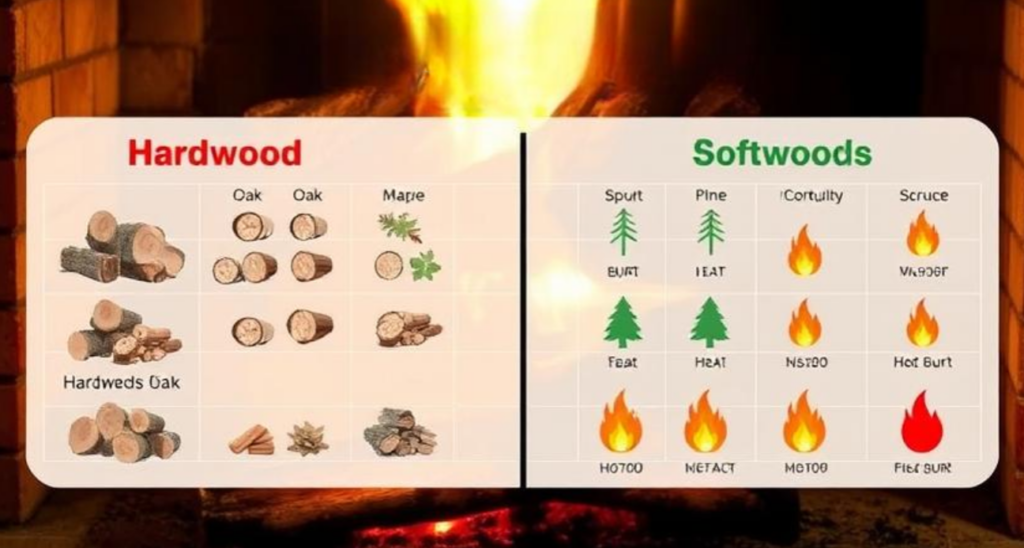Firewood Basics: Cutting, Splitting, and Storing

How to Choose the Right Type of Wood for Firewood

When selecting the right type of wood for firewood, it is important to consider the overall burn quality and heat output of the wood. Hardwoods, such as oak and maple, are known for providing long-lasting and steady heat, making them ideal for use in wood stoves and fireplaces. Softwoods, like pine and spruce, ignite easily but burn quickly and can produce more creosote buildup in chimneys.
In addition to burn quality, it is essential to think about the availability and cost of the wood in your area. Some types of wood may be more readily accessible and affordable than others, so it is beneficial to choose a wood that is both suitable for your heating needs and practical for your budget. Additionally, consider the seasoning time required for different types of wood, as some may need longer to dry out properly before use.
• Hardwoods, such as oak and maple, provide long-lasting and steady heat
• Softwoods, like pine and spruce, ignite easily but burn quickly
• Softwoods can produce more creosote buildup in chimneys
• Consider the availability and cost of wood in your area
• Choose a wood that is suitable for your heating needs and practical for your budget
• Think about the seasoning time required for different types of wood
Best Practices for Cutting Firewood
When it comes to cutting firewood, there are several key practices to keep in mind to ensure efficiency and safety. First and foremost, it is crucial to have the right tools for the job. A sharp chainsaw and protective gear such as gloves, goggles, and sturdy footwear are essential for a smooth cutting process. Additionally, always make sure that the area where you are cutting the firewood is clear of any obstacles to prevent accidents.
Another important practice when cutting firewood is to pay attention to the size and length of the pieces. It is recommended to cut the firewood into manageable lengths that fit easily into your fireplace or wood stove. This not only makes it easier to handle and stack the wood but also ensures a more efficient burning process. Remember to vary the sizes of the pieces to accommodate different firewood needs, whether for kindling or longer burning logs.
• Use a sharp chainsaw and protective gear
• Clear the cutting area of obstacles
• Cut firewood into manageable lengths
• Vary sizes of pieces for different needs
Tips for Properly Splitting Firewood
When it comes to splitting firewood, having the right tools is crucial. A sharp axe or maul will make the task much easier and safer. Make sure the blade is not dull to prevent any injuries or inefficient splitting. Remember to wear appropriate safety gear, such as gloves and safety glasses, to protect yourself while working with sharp tools.
Another important tip for properly splitting firewood is to choose the right size pieces. Aim for pieces that are around 4-6 inches in diameter for easier handling and optimal burning. By splitting your firewood into smaller, uniform pieces, you can ensure a more consistent and efficient burn. This will also help the wood dry out more quickly and evenly, making it ready for use in your fireplace or wood stove.
• Choose the right tools for splitting firewood, such as a sharp axe or maul
• Make sure your blade is sharp to prevent injuries and ensure efficient splitting
• Wear appropriate safety gear like gloves and safety glasses while working with sharp tools
• Aim for pieces of firewood that are around 4-6 inches in diameter for easier handling and optimal burning
• Split your firewood into smaller, uniform pieces for a more consistent and efficient burn
• Smaller pieces will help the wood dry out more quickly and evenly, making it ready for use in your fireplace or wood stove
The Importance of Seasoning Firewood
Seasoning firewood is a crucial step in preparing it for efficient burning in a fireplace or wood stove. Freshly cut wood contains a high moisture content, which can make it difficult to ignite and produce excessive smoke when burned. By allowing firewood to season or dry out properly, the moisture content decreases, making it easier to light and creating a cleaner burn that produces more heat.
Properly seasoned firewood not only burns more efficiently but also reduces the buildup of creosote in the chimney, which can be a fire hazard. This process also helps to prolong the life of your fireplace or wood stove by minimizing the amount of soot and residue that can accumulate over time. Additionally, seasoned firewood produces less smoke and particulate matter, which is better for both indoor air quality and the environment.
• Seasoning firewood is important for efficient burning in a fireplace or wood stove
• Freshly cut wood has high moisture content, making it difficult to ignite and producing excessive smoke
• Allowing firewood to season decreases moisture content, making it easier to light and creating a cleaner burn that produces more heat
• Properly seasoned firewood reduces creosote buildup in the chimney, reducing fire hazards
• Seasoned firewood prolongs the life of your fireplace or wood stove by minimizing soot and residue accumulation
• Seasoned firewood produces less smoke and particulate matter, improving indoor air quality and benefiting the environment
How to Store Firewood Properly
When storing firewood, it is essential to keep in mind a few key factors to ensure it remains in good condition for burning. Firstly, it is crucial to store firewood off the ground to prevent moisture from seeping into the wood, which can lead to mold and decay. Elevating the wood also helps with airflow, aiding in the drying process.
Additionally, when stacking firewood, make sure to leave some space between the logs to allow for proper air circulation. This helps the wood to season more effectively and reduces the risk of mold growth. Choosing a well-ventilated location for storing firewood is also significant to prevent moisture buildup and keep the wood dry and ready for burning.
• Storing firewood off the ground is crucial to prevent moisture seepage
• Elevating wood helps with airflow and aids in drying process
• Leave space between logs when stacking for proper air circulation
• Well-ventilated location is important to prevent moisture buildup
Common Mistakes to Avoid When Handling Firewood

One common mistake to avoid when handling firewood is storing it directly on the ground. Placing firewood on the ground can lead to moisture absorption, making the wood harder to ignite and burn efficiently. To prevent this, elevate the firewood by using a firewood rack or storing it on pallets to allow for airflow underneath.
Another mistake to avoid is burning green or unseasoned firewood. Green wood contains a high moisture content, which can lead to excessive smoke, creosote buildup in chimneys, and lower heat output. It is essential to properly season firewood by allowing it to dry for at least six months to a year before burning it. This will ensure a cleaner burn and more effective heat production for your fires.
• Storing firewood directly on the ground can lead to moisture absorption
• Elevate firewood using a rack or pallets to allow airflow underneath
• Burning green or unseasoned firewood can cause excessive smoke and creosote buildup
• Season firewood for at least six months to a year before burning for cleaner burn and more heat production
The Benefits of Using a Firewood Rack
A firewood rack is a simple yet essential tool for anyone who uses firewood for heating or cooking. By keeping your firewood elevated and off the ground, a firewood rack helps to protect your wood from moisture and pests, ensuring that it burns efficiently when you need it. Additionally, a firewood rack helps to organize and stack your firewood neatly, making it easier to access and use.
In addition to the practical benefits, a firewood rack also adds a tidy and organized look to your outdoor space. Whether you have a backyard fire pit or a wood-burning stove in your home, a firewood rack can help maintain a clean and well-kept appearance. With various sizes and styles available, you can choose a firewood rack that complements your space while also providing the necessary storage for your firewood.
– A firewood rack helps protect your wood from moisture, ensuring it burns efficiently
– Keeps pests away from your firewood
– Organizes and stacks firewood neatly for easy access and use
– Adds a tidy and organized look to your outdoor space
– Various sizes and styles available to complement your space
Safety Precautions When Handling Firewood
When handling firewood, it is essential to prioritize safety to prevent any potential accidents or injuries. One key safety precaution is to wear appropriate protective gear, such as gloves and safety goggles, to shield your hands and eyes from splinters and debris. Additionally, when lifting heavy pieces of firewood, remember to bend at the knees and lift with your legs to avoid straining your back muscles.
Another important safety measure is to be cautious when using tools such as axes, saws, and log splitters. Always maintain a firm grip on the tool and position yourself to ensure a stable stance before starting any cutting or splitting tasks. Furthermore, make sure the cutting area is clear of any obstacles or bystanders to avoid accidents. Proper tool maintenance and sharpening are also crucial for safe and efficient firewood handling.
• Wear appropriate protective gear such as gloves and safety goggles
• Bend at the knees and lift with your legs when lifting heavy pieces of firewood
• Maintain a firm grip on tools such as axes, saws, and log splitters
• Position yourself for a stable stance before starting cutting or splitting tasks
• Ensure cutting area is clear of obstacles or bystanders to avoid accidents
• Proper tool maintenance and sharpening are crucial for safe handling
How to Properly Stack Firewood
Stacking firewood properly is essential to ensure that it stays dry and ready to burn efficiently. When stacking firewood, it is important to choose a well-ventilated location that allows for air circulation to help with the seasoning process. Start by creating a base layer of firewood on a raised platform, such as pallets or concrete blocks, to prevent moisture from seeping into the wood from the ground.
Next, stack the firewood in a crisscross pattern, alternating the direction of the wood with each layer. This helps to create stability in the stack and allows for better airflow between the logs. Make sure to leave space between the pieces of wood to facilitate drying and prevent mold growth. Additionally, covering the top of the stack with a tarp or firewood cover can protect it from rain and snow while still allowing for air circulation.
• Choose a well-ventilated location for stacking firewood
• Create a base layer on a raised platform to prevent moisture seepage
• Stack the firewood in a crisscross pattern for stability and airflow
• Leave space between wood pieces for drying and mold prevention
• Cover the top of the stack with a tarp or firewood cover to protect from elements
The Environmental Impact of Using Firewood
Using firewood as a source of heat has both positive and negative environmental impacts. On the positive side, burning firewood can be considered a carbon-neutral form of energy, as the amount of carbon dioxide released during burning is roughly equal to the amount that the tree absorbed during its growth. This means that if trees are harvested sustainably, the carbon cycle remains balanced. Additionally, using firewood can be more environmentally friendly than relying on fossil fuels for heating purposes, as it is a renewable resource that can be locally sourced, reducing the carbon footprint associated with transportation.
However, there are also negative environmental impacts associated with using firewood. Deforestation can occur if trees are harvested unsustainably or if there is excessive demand for firewood without proper forest management practices in place. Clearing forests for firewood can lead to habitat destruction, loss of biodiversity, and soil erosion. In addition, burning firewood can release pollutants and particulate matter into the air, contributing to air pollution and potential health issues, especially in areas with poor ventilation or where wood is burned inefficiently. It is essential to consider the environmental consequences of using firewood and to implement sustainable practices to minimize its negative impact on the environment.
• Burning firewood is considered a carbon-neutral form of energy
• Amount of CO2 released during burning is equal to what the tree absorbed
• Firewood can be more environmentally friendly than fossil fuels for heating
• Firewood is a renewable resource that can be locally sourced
Negative Impacts:
• Deforestation can occur if trees are harvested unsustainably
• Excessive demand for firewood without proper forest management practices
can lead to habitat destruction and loss of biodiversity
• Clearing forests for firewood can result in soil erosion
• Burning firewood releases pollutants and particulate matter into the air, contributing to air pollution
and potential health issues
DIY Firewood Storage Solutions

For those looking to store firewood in a cost-effective and efficient manner, there are several DIY solutions available. One common method is to build a simple firewood rack using basic materials such as lumber and screws. By constructing a sturdy rack with elevated legs, you can keep your firewood off the ground and protected from moisture, pests, and rot. This type of storage solution also allows for better air circulation around the wood, aiding in the seasoning process.
Another DIY option for firewood storage is utilizing old pallets to create a makeshift woodpile. By disassembling the pallets and reassembling them into a stackable structure, you can easily store large quantities of firewood in a neat and organized fashion. This method is not only cost-efficient but also environmentally friendly, as it repurposes materials that might otherwise go to waste. Additionally, the open design of a pallet woodpile allows for proper ventilation, helping to maintain the quality of the firewood for optimal burning efficiency.
• Building a simple firewood rack using lumber and screws
• Elevating the rack on legs to keep firewood off the ground
• Protecting firewood from moisture, pests, and rot
• Allowing for better air circulation around the wood
• Utilizing old pallets to create a stackable woodpile
• Disassembling and reassembling pallets into a structured design
• Storing large quantities of firewood in a neat and organized fashion
• Cost-efficient and environmentally friendly solution
• Proper ventilation to maintain quality of firewood
When to Replace Old Firewood
Over time, firewood can become less effective at producing heat and flames due to prolonged exposure to moisture and air. When old firewood starts to appear discolored, moldy, or rotten, it is a clear indication that it has deteriorated and should be replaced. Burning old firewood that is in poor condition can lead to increased smoke, difficulty in lighting, and inefficient heat output.
Another sign that it’s time to replace old firewood is when it produces a hollow sound when two pieces are knocked together. This indicates that the wood has lost its density and will not burn as effectively as fresh, dry firewood. To ensure a cozy and warm fire, regularly inspect your firewood supply and replace any pieces that show signs of deterioration.
• Discolored, moldy, or rotten appearance
• Increased smoke and difficulty in lighting
• Inefficient heat output
When firewood produces a hollow sound when knocked together
Regularly inspect firewood supply for signs of deterioration.
The Best Tools for Cutting and Splitting Firewood
Choosing the right tools for cutting and splitting firewood is essential to making the task easier and more efficient. One of the most common tools used for cutting firewood is a chainsaw. Chainsaws are powerful and can quickly cut through thick logs, making them a popular choice for those with a large quantity of firewood to process.
For splitting firewood, a splitting maul is a widely used tool. A splitting maul has a heavy, wedge-shaped head that is specifically designed to split wood along the grain. This tool is effective for breaking apart larger logs into smaller, more manageable pieces. Additionally, a splitting axe can also be used for splitting firewood, especially for smaller pieces that don’t require as much force to split. When choosing tools for cutting and splitting firewood, it’s important to select ones that are sharp, well-maintained, and suited to the size of the logs being processed.
• Chainsaws are powerful tools that can quickly cut through thick logs
• Splitting mauls have a heavy, wedge-shaped head designed to split wood along the grain
• Splitting axes are effective for smaller pieces of firewood that don’t require as much force to split
• It is important to choose sharp, well-maintained tools suited to the size of the logs being processed
How to Tell If Firewood is Seasoned
To determine if firewood is seasoned, look for certain characteristics that indicate it is ready to burn efficiently. Seasoned firewood typically has cracks and checks on the ends of the logs, with the bark starting to loosen or fall off. The color of seasoned firewood tends to be darker and the logs should feel lighter compared to freshly cut wood. In addition, seasoned firewood will make a hollow sound when two pieces are knocked together, signaling that the moisture content is low and suitable for burning.
Another way to test the seasoning of firewood is by checking the moisture content using a moisture meter. Ideally, seasoned firewood should have a moisture content of around 20% or lower. By testing the moisture levels, you can ensure that the firewood will burn efficiently, produce less smoke, and generate more heat for your fireplace or wood stove. Remember that properly seasoned firewood is essential for a safe and efficient fire, so take the time to inspect these indicators before using it.
• Seasoned firewood typically has cracks and checks on the ends of the logs
• The bark may start to loosen or fall off
• The color of seasoned firewood tends to be darker
• Logs should feel lighter compared to freshly cut wood
• Seasoned firewood makes a hollow sound when knocked together
Another way to test the seasoning of firewood is by checking the moisture content using a moisture meter. Ideally, seasoned firewood should have a moisture content of around 20% or lower. By testing the moisture levels, you can ensure that the firewood will burn efficiently, produce less smoke, and generate more heat for your fireplace or wood stove. Remember that properly seasoned firewood is essential for a safe and efficient fire, so take the time to inspect these indicators before using it.
Different Methods for Splitting Firewood
One common method for splitting firewood is using a traditional axe. This involves swinging the axe overhead and bringing it down on the wood with force to split it into smaller pieces. It requires strength and precision to ensure the wood splits cleanly. Another method is using a splitting maul, which is a heavier and blunter tool compared to an axe. The additional weight helps drive the maul through the wood more effectively, making it ideal for larger, tougher pieces of firewood.
Alternatively, some people opt for a hydraulic log splitter for more efficiency. This machine uses hydraulic force to split wood with minimal effort, making it a popular choice for those who have a large amount of firewood to split. Additionally, using a wedge and sledgehammer is another method for splitting firewood. By placing a wedge into the wood and using a sledgehammer to drive it in, the wood is split along the grain. Each method has its own benefits and considerations, so it’s important to choose the one that best fits your skill level and needs.
• Traditional axe: swinging overhead and bringing down with force
• Splitting maul: heavier and blunter tool for tougher pieces of wood
• Hydraulic log splitter: uses hydraulic force for efficiency
• Wedge and sledgehammer: driving wedge into wood to split along the grain
Each method has its own benefits and considerations, so it’s important to choose the one that best fits your skill level and needs. Whether you prefer the traditional approach of using an axe or want to invest in a hydraulic log splitter for efficiency, there are various methods available for splitting firewood. Take into account your strength, the size of the wood you need to split, and how much firewood you typically go through before deciding on the best method for you.
It’s also essential to prioritize safety when splitting firewood. Always wear appropriate protective gear such as gloves and safety glasses to prevent injuries from flying splinters or debris. Make sure your work area is clear of any obstacles or distractions that could cause accidents during the splitting process. By following these guidelines and choosing a suitable method for splitting firewood, you can ensure a successful outcome while staying safe throughout the process.
The Dangers of Burning Unseasoned Firewood

Burning unseasoned firewood can pose several risks to both your health and safety. Freshly cut wood contains a high moisture content, which causes it to burn less efficiently. When unseasoned firewood is burned, it produces more smoke and creosote buildup in the chimney, increasing the risk of chimney fires. Additionally, the lower heat output from burning unseasoned wood can result in a less effective fire, requiring more fuel to maintain warmth.
Aside from the potential safety hazards, burning unseasoned firewood can also lead to environmental concerns. The incomplete combustion of wet wood releases more pollutants into the air, contributing to air pollution and potential health issues. In addition, the excess smoke and soot produced by burning unseasoned wood can deposit harmful substances onto surrounding vegetation and soil, impacting the ecosystem.
• Burning unseasoned firewood can lead to increased smoke and creosote buildup in the chimney
• Higher risk of chimney fires due to incomplete combustion of wet wood
• Lower heat output from burning unseasoned wood may require more fuel to maintain warmth
• Incomplete combustion of wet wood releases more pollutants into the air, contributing to air pollution
• Excess smoke and soot produced by burning unseasoned wood can harm surrounding vegetation and soil
How to Safely Transport Firewood
When transporting firewood, it is essential to secure the load properly to prevent any pieces from falling out during transit. Make sure to stack the firewood neatly and compactly in your vehicle or trailer to minimize movement. Utilizing straps or bungee cords can help to hold the wood in place and prevent it from shifting during transportation.
Additionally, it is crucial to be mindful of weight distribution when loading firewood into your vehicle. Distribute the weight evenly to maintain proper balance and stability while driving. Avoid overloading your vehicle with more firewood than it can safely carry, as this can affect control and handling on the road.
• Stack firewood neatly and compactly in your vehicle or trailer
• Use straps or bungee cords to secure the load
• Be mindful of weight distribution when loading firewood into your vehicle
• Distribute weight evenly for proper balance and stability
• Avoid overloading your vehicle with more firewood than it can safely carry
Understanding the Moisture Content of Firewood
When it comes to using firewood, understanding the moisture content is crucial for efficient burning and preventing potential hazards. The moisture content of firewood refers to the amount of water present in the wood, which significantly impacts its burn quality. Well-seasoned firewood typically has a moisture content of around 20% or less, making it easier to ignite and producing more heat output.
Burning firewood with high moisture content not only results in a more challenging and less efficient burn but also creates more smoke and harmful pollutants. Wet or green wood not only produces more creosote buildup in chimneys but also contributes to air pollution. Ensuring that your firewood is properly seasoned and has a suitable moisture content is essential for both efficient heating and environmental considerations.
• Well-seasoned firewood has a moisture content of around 20% or less
• High moisture content in firewood leads to inefficient burning
• Wet or green wood produces more smoke and harmful pollutants
• Properly seasoned firewood reduces creosote buildup in chimneys
• Ensuring suitable moisture content is essential for efficient heating and environmental concerns
Tips for Efficiently Starting a Fire with Firewood
To efficiently start a fire with firewood, it is crucial to properly arrange the wood in the fire pit or fireplace. Begin by placing crumpled newspaper or small pieces of dry kindling at the bottom of the fire area. Next, stack smaller pieces of firewood on top of the kindling in a crisscross pattern to allow for proper airflow. Gradually add larger pieces of firewood, ensuring that there is enough space between each log to promote good combustion. This layered approach helps the fire burn evenly and sustain itself for a longer period.
In addition to arranging the firewood properly, it is essential to use the right fire-starting technique. One effective method is using a fire starter, such as firelighters or paraffin wax cubes, to ignite the kindling. Alternatively, you can use a small handheld torch to quickly and easily light the kindling. Avoid using accelerants like gasoline or lighter fluid, as they can be dangerous and produce harmful fumes. By following these tips and techniques, you can efficiently start a fire with firewood and enjoy a warm and cozy atmosphere in your home.
• Place crumpled newspaper or small pieces of dry kindling at the bottom
• Stack smaller pieces of firewood on top in a crisscross pattern
• Gradually add larger pieces of firewood with space between each log
• Use a fire starter like firelighters or paraffin wax cubes for ignition
• Avoid using accelerants like gasoline or lighter fluid
By following these tips and techniques, you can efficiently start a fire with firewood and enjoy a warm and cozy atmosphere in your home.
The Cost of Buying vs. Cutting Your Own Firewood
When it comes to sourcing firewood for your home, one of the decisions you’ll need to make is whether to buy it or cut your own. Buying firewood can be a convenient option for those who don’t have the time, tools, or resources to cut and process their own wood. However, the cost of buying firewood can vary depending on several factors, such as the type of wood, the quantity needed, and whether delivery is included. In some cases, purchasing firewood can be more expensive than cutting your own, especially if you have access to free or inexpensive sources of wood on your property or in your local area.
On the other hand, cutting your own firewood can be a cost-effective option for those who are willing and able to put in the time and effort required. By sourcing your own firewood, you can potentially save money on purchasing wood from suppliers. Additionally, cutting your own firewood allows you to have more control over the quality and seasoning of the wood, ensuring that you have a sustainable and reliable source of fuel for your fires. However, it’s important to consider the equipment and tools needed for cutting and processing firewood, as well as the labor involved in splitting, stacking, and storing the wood properly.
• Buying firewood can be convenient for those who lack time, tools, or resources
• Cost of buying firewood varies based on type, quantity, and delivery options
• Purchasing firewood can sometimes be more expensive than cutting your own
• Cutting your own firewood is cost-effective for those willing to put in time and effort
• Sourcing your own firewood can potentially save money compared to buying from suppliers
• Cutting your own allows more control over quality and seasoning of wood
• Consider equipment, tools, labor involved in cutting and processing firewood



